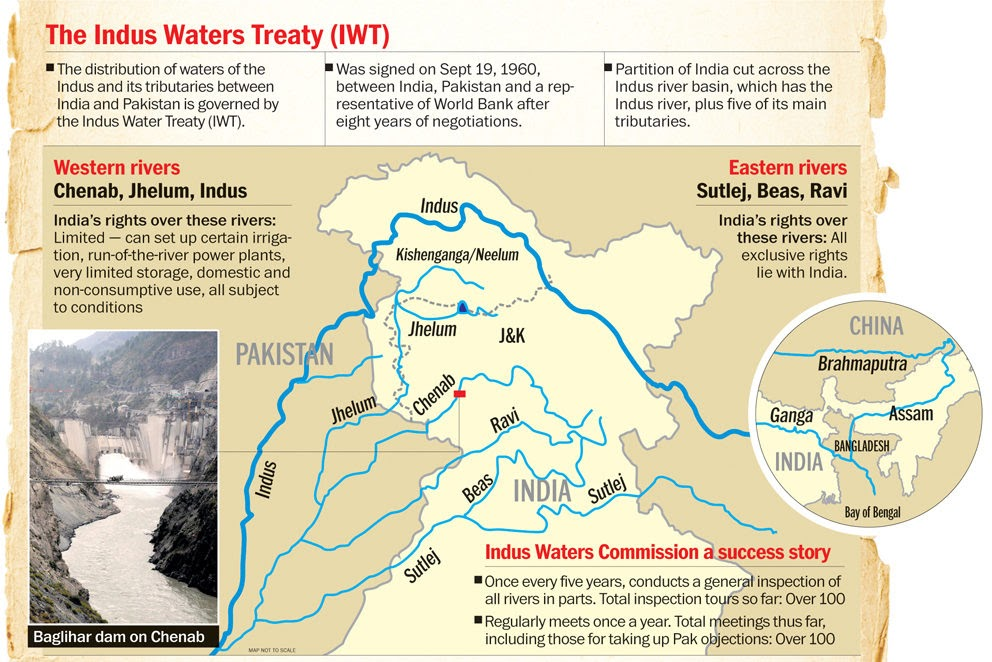International Relations
Indus Water Treaty
- 27 Jun 2024
- 7 min read
Prelims: Kishanganga and Ratle Hydro Electric Projects, Indus Water Treaty (IWT), Indus and its tributaries
Mains: Indus Waters Treaty and associated implementation issues
Why in News?
Recently, a five-member Pakistani delegation was flown to Jammu’s Kishtwar to inspect power projects set up on the rivers covered under the Indus Water Treaty (IWT) of 1960.
What is Indus Water Treaty (IWT)?
- About:
- Indus Waters Treaty was signed on September 19, 1960, between India and Pakistan and was brokered by the World Bank.
- The treaty sets out a mechanism for cooperation and information exchange between the two sides on the use of the water of the Indus River and its five tributaries Sutlej, Beas, Ravi, Jhelum, and Chenab.
- Key Provisions:
- Water Sharing:
- It prescribes how water from the six rivers of the Indus River System would be shared between India and Pakistan.
- It allocated the three western rivers Indus, Chenab and Jhelum to Pakistan for unrestricted use, barring certain non-consumptive, agricultural and domestic uses by India and the three Eastern rivers Ravi, Beas and Sutlej were allocated to India for unrestricted usage.
- This means that 80% of the share of water went to Pakistan while leaving the rest 20% of water for use by India.
- Permanent Indus Commission:
- Under the Indus Waters Treaty, both countries must set up a Permanent Indus Commission, mandated to meet annually.
- Dispute Resolution Mechanism:
- The IWT provides a three-step dispute resolution mechanism under which “questions” on both sides can be resolved at the Permanent Commission, or can also be taken up at the inter-government level.
- Unresolved differences between the countries on water-sharing can be addressed by the World Bank-appointed Neutral Expert (NE).
- Appeal from a Neutral Expert of WB can be referred to a Court of Arbitration set up by the World Bank.
- Water Sharing:
- Various Projects to be Inspected Under IWT:
- Pakal Dul and Lower Kalnai: Pakal Dul Hydro Electric Project built on river Marusudar, a tributary of the Chenab. Lower Kalnai is developed on the Chenab.
- Kishanganga Hydroelectric Project: It is a run-of-the-river project located in J&K.
- Pakistan objected to the project arguing that it would affect the flow of the Kishanganga River (called the Neelum River in Pakistan).
- In 2013, The Hague’s Permanent Court of Arbitration (CoA) ruled that India could divert all the water with certain conditions.
- Ratle Hydroelectric Project: It is a run-of-the-river hydroelectric power station on the Chenab River, in J&K.
Indus River and its Tributaries
- Source:
- The Indus (In Tibetan called Sengge Chu/‘Lion River’), a major river in South Asia, originates in Tibet near Mansarovar Lake in the Trans-Himalaya.
- The river flows through Tibet, India and Pakistan and about 200 million people live in the area of its drainage basin.
- Course and Major Tributaries:
- It enters India through Ladakh and flows through Jammu and Kashmir before reaching Pakistan's Gilgit-Baltistan region.
- The major left-bank tributaries of the Indus River are the Zaskar, Suru, Soan, Jhelum, Chenab, Ravi, Beas, Satluj, and Panjnad rivers.
- The major right-bank tributaries are Shyok, Gilgit, Hunza, Swat, Kunnar, Kurram, Gomal, and Kabul rivers.
- The Indus River empties into the Arabian Sea near the city of Karachi in southern Pakistan.
| River | Source | Joins |
| Jhelum | Spring at Verinag, Kashmir Valley | Chenab at Trimmu, Pakistan |
| Chenab | Chandra and Bhaga streams near Bara Lacha Pass | Satluj after receiving Jhelum and Ravi |
| Ravi | Kullu hills near Rohtang Pass | Chenab near Rangpur, Pakistan |
| Beas | Near Rohtang Pass | Satluj at Harike Barrage, India |
| Satluj | Manasarovar-Rakas Lakes, Tibet | Indus a few kilometres above Mithankot, Pakistan |
Way Forward
- Focus on Technical Dispute Resolution: Both sides should prioritise utilising the treaty's existing framework for resolving technical disputes.
- Transparency and Data Sharing: Both nations can share hydrological data to address mutual concerns.
- Joint Basin Management: Climate change and population growth pose common challenges in the Indus basin, urging joint management for water conservation, flood control, and sustainable usage.
- Political Commitment and Dialogue: Sustainable solutions require a commitment from both governments to prioritize dialogue and cooperation over confrontation.
|
Drishti Mains Question: Q. Discuss the key provisions of the Indus Water Treaty and its significance in India-Pakistan relations. |
UPSC Civil Services Examination, Previous Year Question (PYQ)
Prelims:
Q. With reference to the Indus river system, of the following four rivers, three of them pour into one of them which joins the Indus directly. Among the following, which one is such a river that joins the Indus direct? (2021)
(a) Chenab
(b) Jhelum
(c) Ravi
(d) Sutle
Ans: (d)
Q. Consider the following pairs (2019)
| Glacier | River |
| 1. Bandarpunch | Yamuna |
| 2. Bara Shigri | Chenab |
| 3. Milam | Mandakini |
| 4. Siachen | Nubra |
| 5. Zemu | Manas |
Which of the pairs given above are correctly matched?
(a) 1, 2 and 4
(b) 1, 3 and 4
(c) 2 and 5
(d) 3 and 5
Ans: (a)
Mains:
Q. The interlinking of rivers can provide viable solutions to the multi-dimensional inter-related problems of droughts, floods, and interrupted navigation. Critically examine. (2020)





